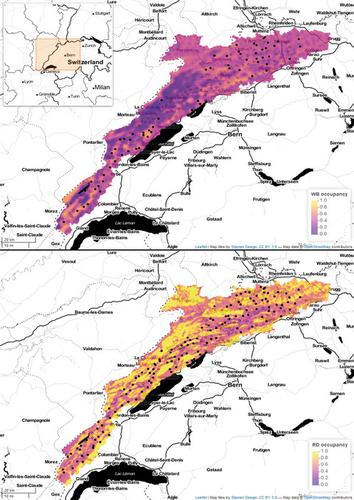当前位置:
X-MOL 学术
›
Remote Sens. Ecol. Conserv.
›
论文详情
Our official English website, www.x-mol.net, welcomes your feedback! (Note: you will need to create a separate account there.)
Modelling species distribution from camera trap by-catch using a scale-optimized occupancy approach
Remote Sensing in Ecology and Conservation ( IF 5.5 ) Pub Date : 2021-05-06 , DOI: 10.1002/rse2.207 Jolien Wevers 1, 2 , Natalie Beenaerts 1 , Jim Casaer 2 , Fridolin Zimmermann 3 , Tom Artois 1 , Julien Fattebert 4, 5
Remote Sensing in Ecology and Conservation ( IF 5.5 ) Pub Date : 2021-05-06 , DOI: 10.1002/rse2.207 Jolien Wevers 1, 2 , Natalie Beenaerts 1 , Jim Casaer 2 , Fridolin Zimmermann 3 , Tom Artois 1 , Julien Fattebert 4, 5
Affiliation

|
Habitat selection is strongly scale-dependent, and inferring the characteristic scale at which an organism responds to environmental variation is necessary to obtain reliable predictions. The occupancy framework is frequently used to model species distribution with the advantage of accounting for imperfect observation, but occupancy studies typically do not define the characteristic scale of the modelled variables. We used camera trap data from winter wildlife surveys in the Swiss part of the Jura Mountains to model occupancy of wild boar (Sus scrofa) and roe deer (Capreolus capreolus). We used a three-step approach: (1) first, we identified factors influencing detectability; (2) second, we optimized the characteristic scale of each candidate explanatory variable; and (3) third, we fit multivariable, multiscale occupancy models in relation to land cover, human presence and topography. Wild boar occupancy was mainly influenced by the interaction between elevation within 2500 m and the proportion of forested areas within a 2500 m, with a nonsignificant additional effect of the interaction between ruggedness within 1900 m and the proportion of forested areas within 2500 m as well as the distance to urban areas. Roe deer occupancy was mainly associated with the interaction between ruggedness within 900 m and the proportion of open landscape within 900 m, with an additional nonsignificant effect of the interaction between elevation within 1500 m and the proportion of open landscape within 900 m as well as the distance to urban areas. Incorporating scale optimization in occupancy modelling of camera trap data can greatly improve the understanding of species-environment relationships by combining the possibility of occupancy models to correct for detection bias and simultaneously allowing to infer the characteristic scale at which certain factors influence the distribution of the organisms studied.
中文翻译:

使用尺度优化的占用方法模拟来自相机陷阱副渔获物的物种分布
栖息地选择强烈依赖于尺度,推断生物体对环境变化做出反应的特征尺度对于获得可靠的预测是必要的。占有率框架经常用于对物种分布进行建模,其优点是可以考虑不完全观察,但占有率研究通常不定义建模变量的特征尺度。我们使用来自侏罗山脉瑞士部分冬季野生动物调查的相机陷阱数据来模拟野猪 ( Sus scrofa ) 和狍 ( Capreolus capreolus ) 的居住情况。)。我们采用了三步法:(1) 首先,我们确定了影响可检测性的因素;(2) 其次,我们优化了每个候选解释变量的特征尺度;(3) 第三,我们拟合与土地覆盖、人类存在和地形相关的多变量、多尺度占用模型。野猪占有率主要受 2500 m 内海拔与 2500 m 内林地比例交互作用的影响,1 900 m 内崎岖度与 2500 m 内林地比例交互作用不显着。到市区的距离。狍占用率主要与 900 m 范围内的崎岖程度与 900 m 范围内开阔景观比例的交互作用有关,1500 m 以内的高程与 900 m 以内的开阔景观比例以及与市区的距离之间的交互作用不显着。在相机陷阱数据的占用建模中结合尺度优化可以通过结合占用模型的可能性来校正检测偏差,同时允许推断某些因素影响生物体分布的特征尺度,从而大大提高对物种 - 环境关系的理解学习了。
更新日期:2021-05-06
中文翻译:

使用尺度优化的占用方法模拟来自相机陷阱副渔获物的物种分布
栖息地选择强烈依赖于尺度,推断生物体对环境变化做出反应的特征尺度对于获得可靠的预测是必要的。占有率框架经常用于对物种分布进行建模,其优点是可以考虑不完全观察,但占有率研究通常不定义建模变量的特征尺度。我们使用来自侏罗山脉瑞士部分冬季野生动物调查的相机陷阱数据来模拟野猪 ( Sus scrofa ) 和狍 ( Capreolus capreolus ) 的居住情况。)。我们采用了三步法:(1) 首先,我们确定了影响可检测性的因素;(2) 其次,我们优化了每个候选解释变量的特征尺度;(3) 第三,我们拟合与土地覆盖、人类存在和地形相关的多变量、多尺度占用模型。野猪占有率主要受 2500 m 内海拔与 2500 m 内林地比例交互作用的影响,1 900 m 内崎岖度与 2500 m 内林地比例交互作用不显着。到市区的距离。狍占用率主要与 900 m 范围内的崎岖程度与 900 m 范围内开阔景观比例的交互作用有关,1500 m 以内的高程与 900 m 以内的开阔景观比例以及与市区的距离之间的交互作用不显着。在相机陷阱数据的占用建模中结合尺度优化可以通过结合占用模型的可能性来校正检测偏差,同时允许推断某些因素影响生物体分布的特征尺度,从而大大提高对物种 - 环境关系的理解学习了。


























 京公网安备 11010802027423号
京公网安备 11010802027423号